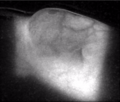Cherenkov radiation
Cherenkov radiation is a fascinating phenomenon that occurs when a charged particle passes through a dielectric medium at a speed greater than the phase velocity of light in that medium. This results in the emission of electromagnetic radiation, known as Cherenkov radiation, which is characterized by its distinctive blue glow.
Overview[edit]
Cherenkov radiation was first discovered by the Soviet scientist Pavel Alekseyevich Cherenkov in 1934, who was awarded the Nobel Prize in Physics in 1958 for his groundbreaking work. This phenomenon is a direct consequence of the speed of light being slower in a medium than in a vacuum.
When a charged particle, such as an electron or a muon, moves through a dielectric medium, it polarizes the atoms or molecules in the medium, causing them to become temporarily electric dipoles. These dipoles then emit electromagnetic waves, which interfere constructively and create a coherent wavefront of Cherenkov radiation.
Properties[edit]
Cherenkov radiation is characterized by its distinctive blue color, which is a result of the radiation's wavelength being in the ultraviolet to visible range. The intensity and angle of the emitted radiation depend on the particle's velocity and the refractive index of the medium.
The intensity of Cherenkov radiation is proportional to the square of the particle's charge and the length of its path through the medium. Additionally, the angle at which the radiation is emitted is determined by the ratio of the particle's velocity to the speed of light in the medium, known as the Cherenkov angle.
Applications[edit]
Cherenkov radiation has found numerous applications in various fields of science and technology. One of its most notable applications is in the detection of high-energy particles in particle physics experiments. By detecting the Cherenkov radiation emitted by charged particles, scientists can determine their energy and velocity, providing valuable insights into the fundamental properties of matter.
In addition to particle physics, Cherenkov radiation is also used in medical imaging techniques such as positron emission tomography (PET). In PET scans, radioactive isotopes emit positrons, which produce Cherenkov radiation when they interact with the surrounding tissue. This radiation can be detected and used to create detailed images of the internal structures of the body.
See Also[edit]
- Pavel Alekseyevich Cherenkov
- Dielectric medium
- Refractive index
- Particle physics
- Positron emission tomography
References[edit]
<references />
-
Advanced Test Reactor
-
Cherenkov Radiation During Maintenance
-
Cherenkov Radiation Animation
-
Reactor Core from Above
-
Cherenkov Radiation
-
Cherenkov Radiation in Breast
-
TRIGA Reactor Core
Ad. Transform your life with W8MD's Budget GLP-1 injections from $75


W8MD offers a medical weight loss program to lose weight in Philadelphia. Our physician-supervised medical weight loss provides:
- Weight loss injections in NYC (generic and brand names):
- Zepbound / Mounjaro, Wegovy / Ozempic, Saxenda
- Most insurances accepted or discounted self-pay rates. We will obtain insurance prior authorizations if needed.
- Generic GLP1 weight loss injections from $75 for the starting dose.
- Also offer prescription weight loss medications including Phentermine, Qsymia, Diethylpropion, Contrave etc.
NYC weight loss doctor appointmentsNYC weight loss doctor appointments
Start your NYC weight loss journey today at our NYC medical weight loss and Philadelphia medical weight loss clinics.
- Call 718-946-5500 to lose weight in NYC or for medical weight loss in Philadelphia 215-676-2334.
- Tags:NYC medical weight loss, Philadelphia lose weight Zepbound NYC, Budget GLP1 weight loss injections, Wegovy Philadelphia, Wegovy NYC, Philadelphia medical weight loss, Brookly weight loss and Wegovy NYC
|
WikiMD's Wellness Encyclopedia |
| Let Food Be Thy Medicine Medicine Thy Food - Hippocrates |
Medical Disclaimer: WikiMD is not a substitute for professional medical advice. The information on WikiMD is provided as an information resource only, may be incorrect, outdated or misleading, and is not to be used or relied on for any diagnostic or treatment purposes. Please consult your health care provider before making any healthcare decisions or for guidance about a specific medical condition. WikiMD expressly disclaims responsibility, and shall have no liability, for any damages, loss, injury, or liability whatsoever suffered as a result of your reliance on the information contained in this site. By visiting this site you agree to the foregoing terms and conditions, which may from time to time be changed or supplemented by WikiMD. If you do not agree to the foregoing terms and conditions, you should not enter or use this site. See full disclaimer.
Credits:Most images are courtesy of Wikimedia commons, and templates, categories Wikipedia, licensed under CC BY SA or similar.
Translate this page: - East Asian
中文,
日本,
한국어,
South Asian
हिन्दी,
தமிழ்,
తెలుగు,
Urdu,
ಕನ್ನಡ,
Southeast Asian
Indonesian,
Vietnamese,
Thai,
မြန်မာဘာသာ,
বাংলা
European
español,
Deutsch,
français,
Greek,
português do Brasil,
polski,
română,
русский,
Nederlands,
norsk,
svenska,
suomi,
Italian
Middle Eastern & African
عربى,
Turkish,
Persian,
Hebrew,
Afrikaans,
isiZulu,
Kiswahili,
Other
Bulgarian,
Hungarian,
Czech,
Swedish,
മലയാളം,
मराठी,
ਪੰਜਾਬੀ,
ગુજરાતી,
Portuguese,
Ukrainian






